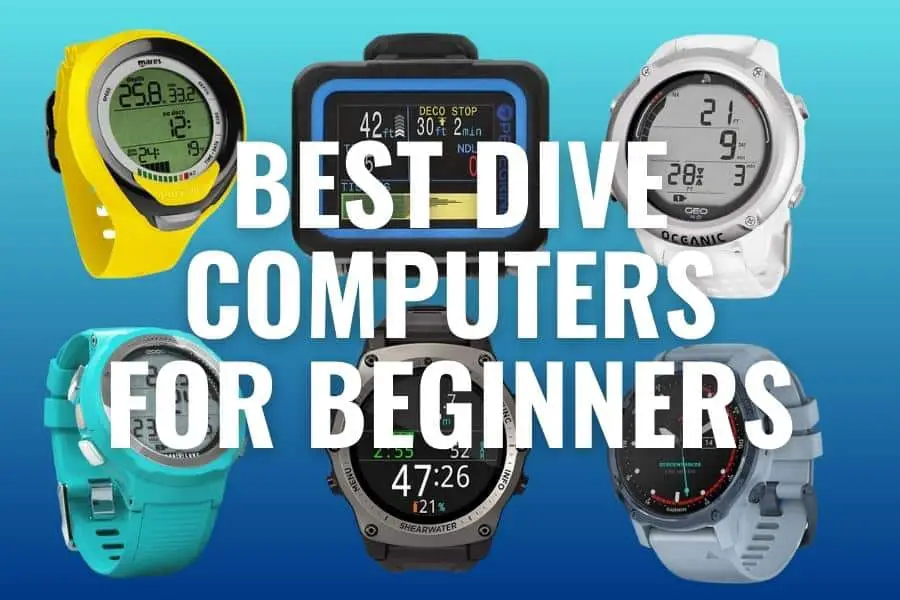I have a confession to make. I didn’t buy a dive computer until my 100th dive and in hindsight, I realized that this was such an irresponsible decision on my part. I used to rent most of my gear and it was not part of the gear rental set, so I thought it was fine to dive without one. I relied on my DM’s dive computer, which I now know was completely unsafe since we both dived differently.
While you can dive without a computer, no one really wants to whip out their dive tables and compute for the residual nitrogen in their body in the middle of their vacation. And besides, you most likely have forgotten how to use those after your open water class, right?
Thankfully, despite my lack of having my own dive computer or forgetting to use a dive table to plan my dives, I’ve never gotten into a dive accident.
But if I were to give a new scuba diver some advice on what dive gear to buy first , I would recommend getting yourself a dive computer as a priority.
So if you’re a new diver wanting to purchase your first dive computer, then you’ve come to the right place!
With so many scuba diving computers available in the market today, it may be difficult and overwhelming to choose especially when you don’t know what you should be looking. But don’t worry, I know how you feel, which is why I put together this guide to assist you in making an educated choice on what would be the best dive computer for you.
Continue reading for my recommendations on the best dive computers for beginners.
- What is a dive computer?
- Why do you need a dive computer?
- Best dive computers for beginners
- 1. Cressi Leonardo Dive Computer
- 2. Suunto Zoop Novo
- 3. Cressi Donatello Dive computer
- 4. Mares Puck Pro Plus Dive Computer
- 5. Oceanic Geo 4.0
- 6. Aqualung I200C Dive Computer
- 7. Shearwater Research Peregrine Dive Computer
- 8. Suunto D5 scuba diving computer
- 9. Garmin Descent Mk2S Dive Smart watch
- 10. Shearwater Teric wrist computer with a transmitter
- How to choose a dive computer
What is a dive computer?
A dive computer is a specialized equipment that scuba divers use to track and monitor vital information during a dive. It detects your depth, dive duration, and water temperature, and calculates vital data like decompression limits and ascent rates.
Why do you need a dive computer?
A dive computer is a specialized equipment that scuba divers use to track and monitor vital information during a dive. It detects your depth, dive duration, and water temperature, and calculates vital data like decompression limits and ascent rates.
Scuba divers benefit from using dive computers because they can keep you safe and help plan your dives better. These gadgets enable divers to make educated decisions by giving real-time data and reminders during the dive.
A dive computer gives real-time depth and dive duration information, removing the need for manual computations and letting divers to concentrate on the experience rather than tedious calculations. This streamlines the diving procedure and decreases the possibility of mistakes leading to diving-related accidents.
Dive computers have algorithms that calculate and show critical decompression data. These algorithms take into account elements like depth, duration, and nitrogen absorption to ensure that divers may ascend safely and prevent decompression sickness
Dive computers also give auditory and visual alarms to divers, informing them of safety restrictions, ascent rates, and remaining bottom time. These reminders assist you in maintaining safe diving habits and to dive within your limits.
Best dive computers for beginners
Here are the beginner-friendly dive computers you can check out. I’ve arranged this list from the most affordable to high end models as I understand this is a huge factor for many people.
1. Cressi Leonardo Dive Computer

Display and readability: Large Numerical Displays
User interface and ease of use: Single Button, Simple & Functional Design, Compact & Travel-Friendly, Three levels of user adjustable conservatism, Visual and distinct, Easy-to-hear audible alarms.
Nitrox compatibility: FO2 adjustable between 21% and 50%. PO2 adjustable between 1.2 bar and 1.6 bar. CNS oxygen toxicity graphic indicator.
Decompression algorithm: RGBM (Reduced Gradient Bubbles Model), Bruce Wienke/Haldane Model
Modes: Air, Nitrox & Gauge
Air integration: No
Maximum Operating Depth: 393 feet / 120 meters
Color options: Black, Blue, Yellow, Orange, White, Pink, Gray, Red, Lime, Lilac, Camouflage
Dive History: 60 dives / 75 hours
Battery life and power management: Battery life indicator. User changeable battery. Battery model: CR2430.
Software and connectivity: Uses IR to connect to the diving computer and a USB cable for PC connection. Software is compatible with all versions of Windows and with Mac.
2. Suunto Zoop Novo

Display and readability: Enlarged segment matrix screen, excellent contrast and information with bigger and clearer digits
User interface and ease of use: 4 Button Interface, decompression stop data, audible alarms, simple menus
Nitrox compatibility: 21% to 50% Oxygen mixtures
Decompression algorithm: Suunto RGBM (Reduced Gradient Bubbles Model)
Modes: Air, Nitrox, Gauge, Free
Air integration: No
Maximum Operating Depth: 260 feet / 80 meters
Color options: Black, Yellow, Blue
Dive History: 140-hour profile and logbook memory
Battery life and power management: User-replaceable 3-volt CR2450 lithium-ion battery
Software and connectivity: USB cable enables you to connect your dive computer to Suunto DM5, available for PC and Mac
3. Cressi Donatello Dive computer

Display and readability: User-Friendly Display System with the information display, screen contrast, proportions, and digit size carefully chosen for ease of use
User interface and ease of use: Single Button, Simple & Functional Design, Compact & Travel-Friendly, Three levels of user adjustable conservatism, Visual and distinct, Easy-to-hear audible alarms.
Nitrox compatibility: FO2 adjustable between 21% and 50%. PO2 adjustable between 1.2 bar and 1.6 bar. CNS oxygen toxicity graphic indicator.
Decompression algorithm: RGBM (Reduced Gradient Bubbles Model) , Bruce Wienke/Haldane Model
Modes: Air, Nitrox, Gauge and Free mode
Air integration: No
Maximum Operating Depth: 492 feet / 150 meters
Color options: Black, Blue, Yellow, Orange, White, Pink, Silver, Red, Lime
Dive History: 50 dives per category
Battery life and power management: Battery life indicator, User-changeable CR2430 battery
Software and connectivity: The interface (not included) uses IR to connect to the diving computer and a USB cable for PC connection. The Interface software is compatible with all versions of Windows and Mac computers and is also available with Bluetooth connectivity for connecting the device to the smartphone.
4. Mares Puck Pro Plus Dive Computer
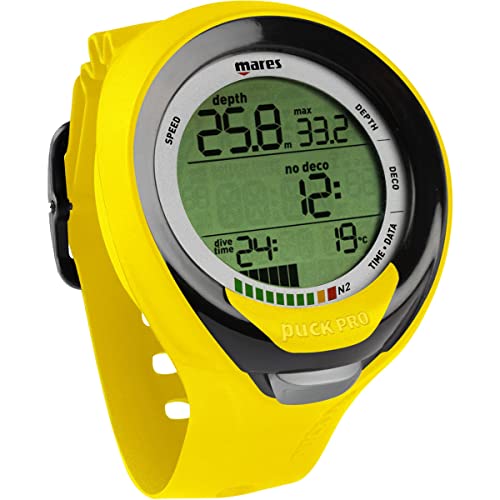
Display and readability: Large digit segmented display
User interface and ease of use: All functions can be accessed with a single button, audible alarms, intuitive menu navigation
Nitrox compatibility: Handles multi-blend dives with up to two Nitrox blends (21-99%)
Decompression algorithm: Mares-Wienke RGBM (Reduced Gradient Bubbles Model) Algorithm
Modes: Air, Nitrox & Bottom Timer
Air integration: No
Maximum Operating Depth: 492 feet / 150 meters
Color options: Black, White, Blue, Yellow,
Dive History: 36 hours
Battery life and power management: User-Replaceable CR 2450 Lithium-Ion Battery
Software and connectivity: USB interface for logging dives on your PC and Mac
5. Oceanic Geo 4.0

Display and readability: Backlight for night or low light conditions
User interface and ease of use: Dual Time Display & Daily Alarms, Intuitive User Interface, Deep Stop w/Countdown Timer, Audible Alarms w/User Acknowledgment
Nitrox compatibility: 2 Nitrox Mixes to 100% Oxygen
Decompression algorithm: Pelagic DSAT (Spencer/Powell data base), Pelagic Z+ (Buhlmann ZHL-16C data base)
Modes: Air, Nitrox, Free dive, Gauge
Air integration: No
Maximum Operating Depth: 328 feet / 100 meters
Color options: Black, White
Dive History: 24 Dives/99 Free Dives
Battery life and power management: User Replaceable 3-Volt CR2430 Lithium Battery
Software and connectivity: Bluetooth 4.0 Connectivity, Download your dives to your phone using DiverLog+ app, User Upgradeable Firmware, PC Interface (with optional cable)
6. Aqualung I200C Dive Computer
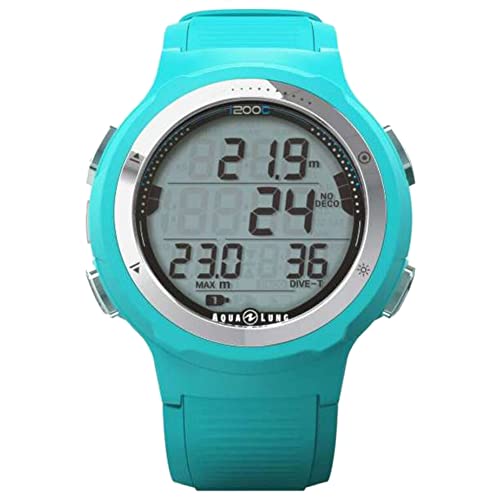
Display and readability: Large segmented matrix screen
User interface and ease of use: Audible alarms and additional high-visibility LED warning light, single button access to last dive display, fresh design, everyday sports watch
Nitrox compatibility: Switches between 2 Nitrox Mixes, Mixes up to 100% O2, Max PO2 1.1 to 1.6
Decompression algorithm: Buhlmann ZHL-16C based PZ+ algorithm
Modes: Air, Nitrox, Free Dive, Gauge
Air integration: No
Maximum Operating Depth: 330 feet / 100 meters
Color options: Black, Charcoal Grey, Light Grey, Blue, Orange, Turquoise, Pink, Petrol, Lime
Dive History: 24 dives
Battery life and power management: User Replaceable CR2430 Battery
Software and connectivity: Bluetooth connectivity lets you share your stats, location, memories, and photos on social media via the free DiverLog+ app on Mac and PC platforms
7. Shearwater Research Peregrine Dive Computer

Display and readability: full colour 5.59cm LCD screen with vivid, enhanced colour range and saturation display
User interface and ease of use: Customize the display to show what is important for you, simple to navigate with a two-button interface, vibrational alerts, never lockout for dive plan deviations
Nitrox compatibility: 3 Gas switchable underwater with full decompression support. up to 100% O2
Decompression algorithm: Bühlmann GF
Modes: Air, Nitrox, 3 Gas Nitrox, Gauge
Air integration: No
Maximum Operating Depth: 394 feet / 120 meters
Color options: Black, White, Gray
Dive History: Approximately 200 Hours
Battery life and power management: Battery life per charge is up to about 30 hours on medium brightness level. USB wireless charging station is included.
Software and connectivity: Connect through Bluetooth and send data to multiple devices via the Shearwater Cloud app
8. Suunto D5 scuba diving computer

Display and readability: full color display w/LED backlight
User interface and ease of use: three buttons to easily switch between views and settings, vibrating and audio alarms, 3D tilt-compensating digital compass
Nitrox compatibility: can be set for up to 3-gas mixtures from 21% to 99% oxygen
Decompression algorithm: Suunto Fused RGBM2
Modes: Air, Nitrox, Free dive, gauge
Air integration: Yes, can seamlessly connect to 3 different transmitters for multi-tank diving
Maximum Operating Depth: 330 feet / 100 meters
Color options: Black, white, amber, ocean, sakura, blue, lime, coral
Dive History: 200 hours
Battery life and power management: Rechargeable battery that will provide up to 6-12-hours of dive time
Software and connectivity: Transfer your dive logs via Bluetooth using the Suunto app, connect to your PC or Mac with a USB cable
9. Garmin Descent Mk2S Dive Smart watch
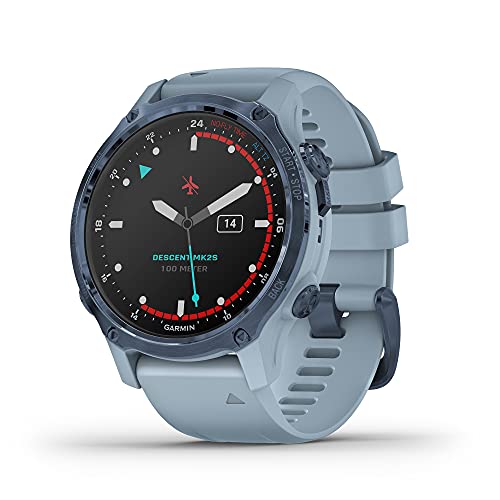
Display and readability: Sunlight-readable 1.2” color display
User interface and ease of use: Works as a smartwatch, Built-in support for multiple sports apps, advanced training features, surface GPS for estimated entry and exit points when diving, includes an underwater compass, audible & vibration alarms, Built-in barometer and tides,
Nitrox compatibility: Up to 100% O2, 1 Bottom Gas & Up to 11 Deco and/or Backup Gasses
Decompression algorithm: Buhlmann ZHL-16c with Gradient Factors
Modes: Single-Gas, Multi-Gas, CCR, Gauge, Apnea, Apnea Hunt
Air integration: No
Maximum Operating Depth: 330 feet / 100 meters
Color options: Black, Blue,
Dive History: Store up to 200 dives
Battery life and power management: Up to 30 hours in dive mode, 7 days in smartwatch mode and 6 hours in GPS mode with music
Software and connectivity: Upload, share and review dives in the Garmin Dive app
10. Shearwater Teric wrist computer with a transmitter
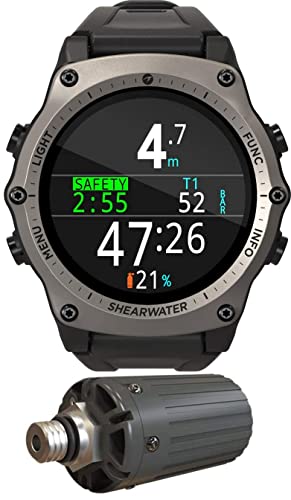
Display and readability: Uses AMOLED screen which is the same technology used in top smartphones, option to display information in a variety of color schemes, larger display and high contrast to make it easy to read
User interface and ease of use: Intuitive controls and menu navigation, has a programmable button that lets the diver access their most frequently used functions with one touch, programmable timers, alarms and stopwatch, digital compass,
Nitrox compatibility: Supports Nitrox, Trimix and multigas
Decompression algorithm: Bühlmann GF
Modes: Recreational, Technical, Rebreather or Free diving
Air integration: Yes, it can connect with up to 4 transmitters
Maximum Operating Depth: 660 feet / 200 meters
Color options: Black, Silver, Blue and Bronze bezels, 15 color options for your watch face
Dive History: 300 dive hours with 5 years storage time
Battery life and power management: Rechargeable Li-ion Battery, up to 30 hours on dive mode and 50 on watch mode
Software and connectivity: Link to your devices via a bluetooth connection and review, edit and synchronize dive logs using the Shearwater Cloud app
How to choose a dive computer
Here are the things you need to consider when buying your first dive computer.
Assess your diving needs
When deciding on the best dive computer for your needs, it’s important to consider your diving experience and style. If you’re a beginner diver, you may want to opt for a simpler dive computer that provides the basics such as depth, time, and no-decompression limits.
But you might also consider your future goals in diving. It might be worth it to invest in a more advanced dive computer with additional features that can assist you in your dive goals. For instance, if you might want to pursue technical diving or freediving, it might make sense to get a dive computer that can accommodate those types of diving.
You may want to start with something basic but it may be worth it to pay a bit more for a dive computer that you know can grow with you. Dive computers are meant to last for many years with proper care. Rather than replacing them year after year, it might save you more in the long run to buy a dive computer that you can use in more advanced dives.
Look for essential features and specifications
When selecting your first dive computer, it’s crucial to consider essential features and specifications that meet your diving needs and goals.
Some things you can look at are:
- Display and readability– How easy or hard is it to read underwater? If you have poor eyesight or dive in areas where visibility isn’t so great, you will definitely want something with high contrast and big numbers.
- User interface and ease of use- How easy or hard is it to use? What settings can you customize? What safety feature does it have? Do you want a computer that requires minimal setup or configuration, or are you willing to invest time and effort in learning how to use a complex device? A user-friendly interface and intuitive navigation can make a significant difference in your overall diving experience.
- Nitrox compatibility– While almost all current dive computers can program nitrox mixes (either 21-50% or 21-100%), more advanced dive computers can program several nitrox mixes that can be swapped at depth. If you’re planning on pursuing technical diving, you may want to check what mixes are allowed on your dive computer.
- Decompression Algorithm– Dive computers use a mathematical algorithm that calculates your bottom time and ascent to avoid decompression sickness. Using your dive profile, it estimates how quickly nitrogen is absorbed into your body, and how quickly it is removed on ascent. Dive computers make use of different algorithm with RGBM (Reduced Gradient Bubble Model and Buhlmann ZHL-16C as the most common ones used. Some people may not care about this specification when deciding on which computer to buy for the first time, but some dive computers are said to be more “conservative” than most due to their algorithm. If you like to learn more about this, you can check out this guide to understanding dive computer algorithm.
- Modes– the most basic dive computers for beginners will have both Air and Nitrox settings but you can also get dive computers with Freediving settings or even use it as a smartwatch for everyday use. Rather than spending on two or more devices, you can consider just investing on one device that you can use for all your activities.
- Air integration– An air-integrated dive computer allows divers to see their live cylinder pressure on their computer screen by employing a wireless transmitter. Traditionally divers will have to check their pressure gauge on how much air they have but nowadays you can attach a transmitter to your tank so you can check your dive computer for this information. Transmitters will cost extra but this can help you easily track your air consumption and avoid running out of air.
- Maximum Operating Depth: As a beginner, you need not worry about this as most computers are rated deeper than recreation limits. However if you wish to pursue technical diving, some computers are rated to with stand pressures from 100-200 meters
- Color options– If you like diving in your favorite color, many dive computers nowadays come in a variety of colors. You’re no longer limited to neutral colors like black and white.
- Dive History– Dive computers have the ability to record your dives. As a new diver, it’s important to keep a record of your dives and the dive computer can help you track your achievements.
- Battery life and power management– Dive computers run on batteries and you don’t want it running out of power right before your dive, or worst, right in the middle of it. Some things to consider when buying your dive computer is how easy it is to replace the batteries or recharge your device. For some you can easily replace the battery yourself, while other suggest you bring it in for servicing to avoid issues with the warranty. Some dive computers come with rechargeable batteries, but you need to factor in how often you need to recharge.
- Software and connectivity– For those who want to keep a record of their dive, accessing the data on your dive computer might be something you also want to consider. Not all dive computers will have Bluetooth capabilities so you might need a USB cable to transfer your dive data unto your computer.
By taking the time to research and compare different dive computers based on these key features and specifications, you can narrow down your options and choose the one that fits your diving style.
Buy within your budget
Another key consideration when choosing your dive computer is your budget.
There is a good selection of dive computers for beginners to fit a variety of budgets, without sacrificing safety and functionality. There is no reason for you to go into debt for your first dive computer.
Diving entails more than just the computer. I’m sure you have fins, masks, regulators, and other items on your wish list. By keeping to your budget, you’ll have money left over to invest in other necessary equipment.
As a starting diver, you don’t need the most expensive dive computer. There are plenty of excellent solutions that will not break the wallet. As you get more diving experience, you’ll have a better understanding of your individual requirements and upgrade your dive computer accordingly.
Consider the After-care support
Before you make that dive computer decision, check out the after-care support offered by the manufacturer.
Even the best dive computers might run into technical hiccups. Having reliable after-care support means you have a safety net. If you encounter any issues with your dive computer, you can count on their expertise to troubleshoot and get you back in the water quickly.
Dive technology keeps evolving, and manufacturers often release software updates to improve performance or add new features. A dive computer with good after-care support ensures you can easily access these updates, keeping your device up-to-date and performing at its best.
A dive computer with solid after-care support typically comes with a good warranty. So, if anything goes wrong within the warranty period, you can get it repaired or replaced hassle-free.
Find out if the brand you choose has service centers in your local area. You don’t want to be inconvenienced should your dive computer need any repair or replacement.
Knowing that you have reliable after-care support gives you peace of mind.
Choosing your first dive computer can be a confusing endeavor but it doesn’t have to be. With my recommendations for the top dive computers for beginners, you can make an informed decision so you can find the best match for you.
Once you’ve purchased your own dive computer, don’t forget to read my best tips on how to care for your dive computer. It’s important to take care of your investment, so it can take care of you.
